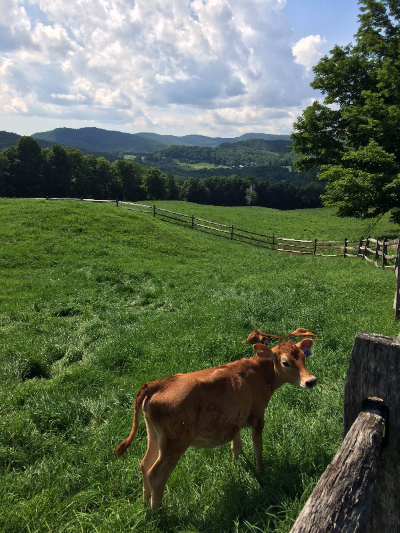Close your eyes. Picture a farm. What do you see? A big red barn? Shady pastures? Some rooting pigs? Strutting turkeys and curious chickens pecking away at grubs? Idyllic green meadows sprawling across rolling hills, with a tawny brown cow or two lazily chewing cud in the warm summer sun as puffy white clouds roll through the perfectly blue sky?
If that’s what you pictured, then let me tell you, Dorothy: your imaginary farm is real. It’s Spring Brook—a dairy farm in Reading, Vermont.
While there are a few bucolic dairy farms left, they’re hardly the norm.
These days, most dairy cows live their whole lives cooped up by the hundreds inside in barns with concrete floors, never getting outside to graze. Instead of eating fresh grass they’re fed silage, a damp, dank, fermented mix of grasses and grains. Ninety-five percent of dairy cattle in the US are Holsteins, which produce more milk than other breeds, in large part because they’ve been bred to be huge, and especially to have enormous udders. These gargantuan cows produce more milk than cows ever have before—dairy cows today produce as much as seven times more milk per year than dairy cows did a century ago!—which is great for expense reports but not so good for the cows. Carrying around so much extra bulk and milk often causes a cow’s legs to bow out—an issue that’s exacerbated by standing and walking on hard, slippery concrete. Every year as many as half of all dairy cows that live on concrete become lame. While healthy cows can live a decade or two, today due to lameness or illness most dairy cows are sent to the slaughterhouse at just three or four years old.
That’s okay for the industry—they just keep breeding more giant dairy cows. The milk they produce gets pooled together with milk from other dairy farms, and then it all gets trucked to a factory to be pasteurized and then bottled in gallon jugs for the grocery or made into big blocks of cheddar or bags of shredded mozzarella.
What happens at Spring Brook Farm is completely different. It’s much more like what would have been happening on family farms across New England 150 years ago. A few dozen Jersey cows spend their days grazing in the fields, as the weather allows. In the winter, when the grass is covered by snow, they still get outside for fresh air and exercise but when they come back in the barn they’re given hay grown on the farm and a bit of grain, never silage. With better nutrition and living conditions, the cows live longer. Lilly, one of the most productive milkers at Spring Brook, is ten years old.
Jerseys are smaller than Holsteins and produce less milk, but their milk is higher in butterfat, making it more flavorful. When Spring Brook owners Karli and Jim Hagedown started the farm twenty-some years ago, they sold the milk. But in 2007, they decided to take their milk and start making it into cheese. Their cheesemaking room is adjacent to the milking parlor. Their prize cheese is Tarentaise.
Tarentaise is a farmstead cheese. What’s that mean?
Farmstead cheese means cheese that is made at the farm using only milk from the farmer’s own animals. We have a few farmstead cheeses in our cheese cave (Essex Manchego from Spain, Raw Milk Stichelton from the UK, and Pleasant Ridge Reserve from Wisconsin are a few that come to mind), but making cheese on the farm using only your own animals’ milk is a pretty uncommon thing these days, even among traditionally made cheeses. It’s like a restaurant that makes food using only the vegetables grown on their own farm, or a baker who makes bread using only wheat grown in his own field. It’s very rare. It’s very hard to do. But it’s often very, very tasty.
When you make a farmstead cheese, in some ways you have more control because you’re involved in every part of the process: you oversee the care and feed given to the animals, you can tweak the recipe for the cheese based on your knowledge of changing conditions day to day or season to season. But at the same time, you are also more bound to those changing conditions day to day: if there’s bad weather on your farm, or an accident takes place, you can’t supplement your supply of milk with some from another source. When you make cheese from milk pooled from multiple sources, the cheese is more homogenous—which is to say, less interesting. Farmstead cheeses tend to be a bit more complex and nuanced, with a bit more variation from batch to batch. In the hands of a great cheesemaker, that can make for some exceptionally flavorful cheese.
Tarentaise is one exceptionally good cheese.
Its recipe is based on mountain cheeses of the French Alps, a bit like Beaufort or Comte: it’s made with raw (unpasteurized) milk, made into big wheels, and it spends several months aging before it’s ready to eat. The flavor is a bit nutty, a bit fruity, and often reminds me of freshly-baked bread. Like other mountain cheeses, it would be great with a bit of fresh or dried fruit, or a handful of nuts. And since it’s a cooked curd cheese, like Parmigiano-Reggiano or Gruyere, it melts beautifully, getting creamy, not stringy. It’s an awesome choice for fondue or a killer grilled cheese sandwich.

